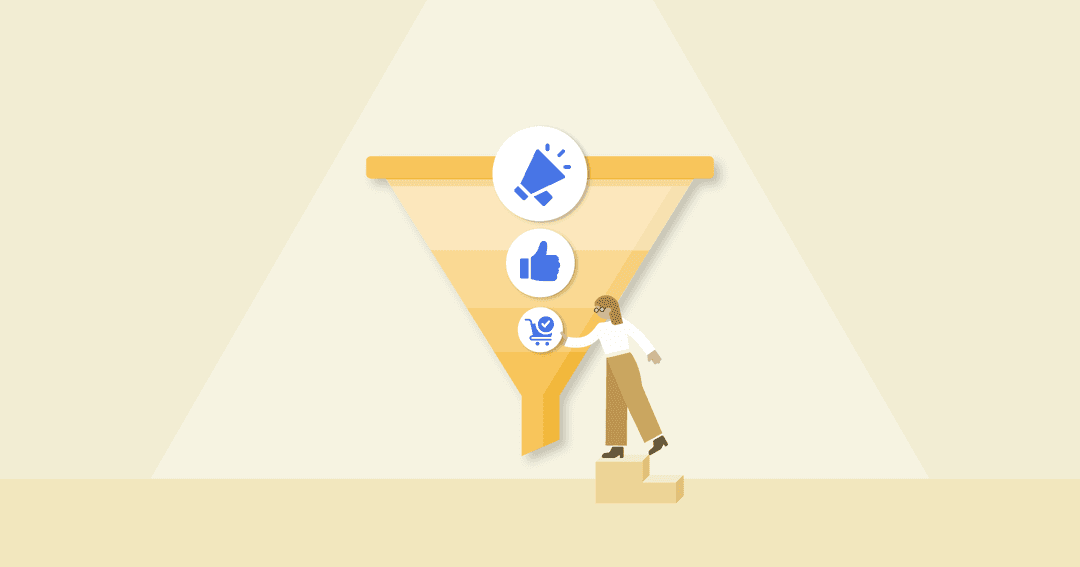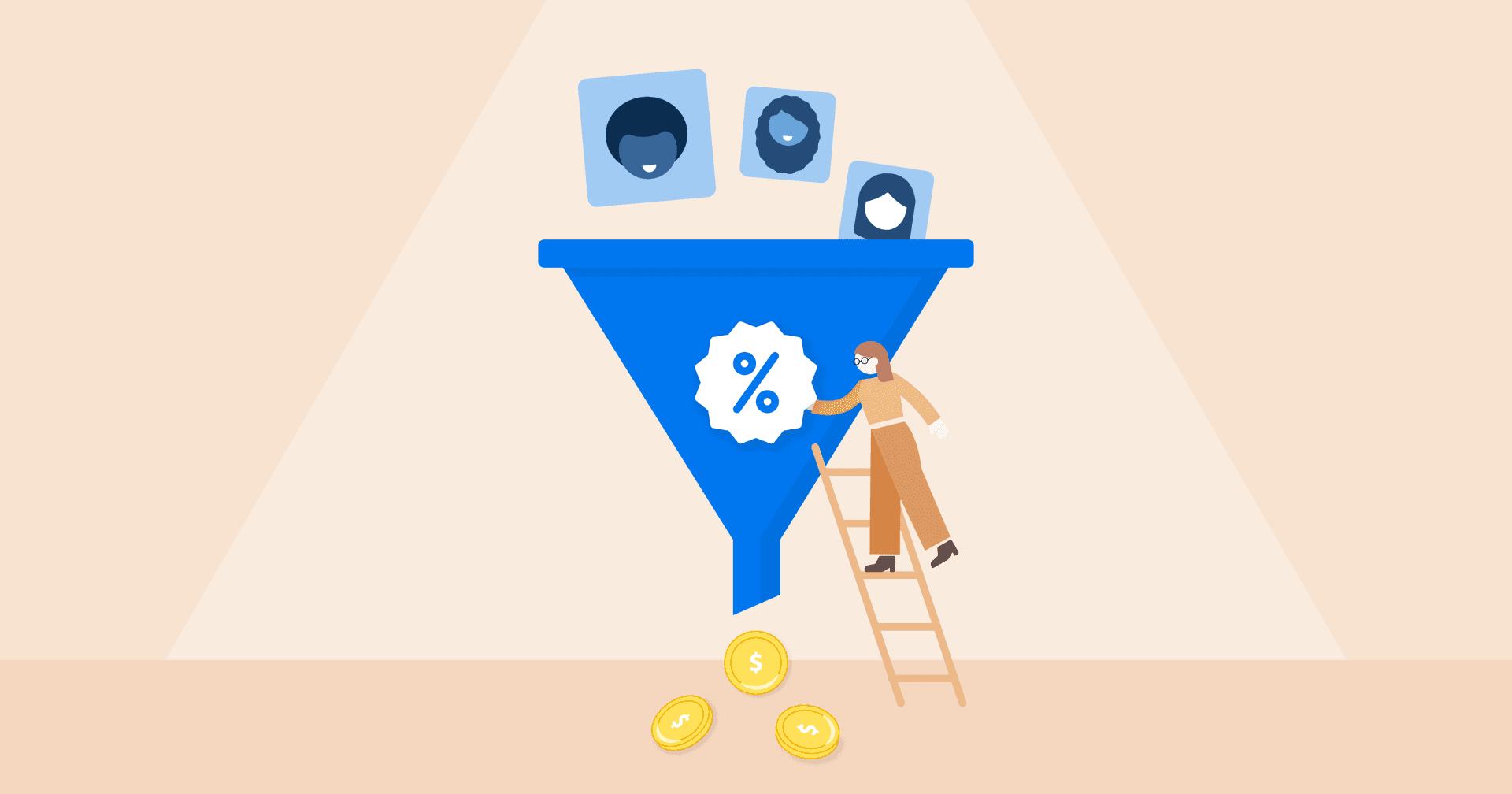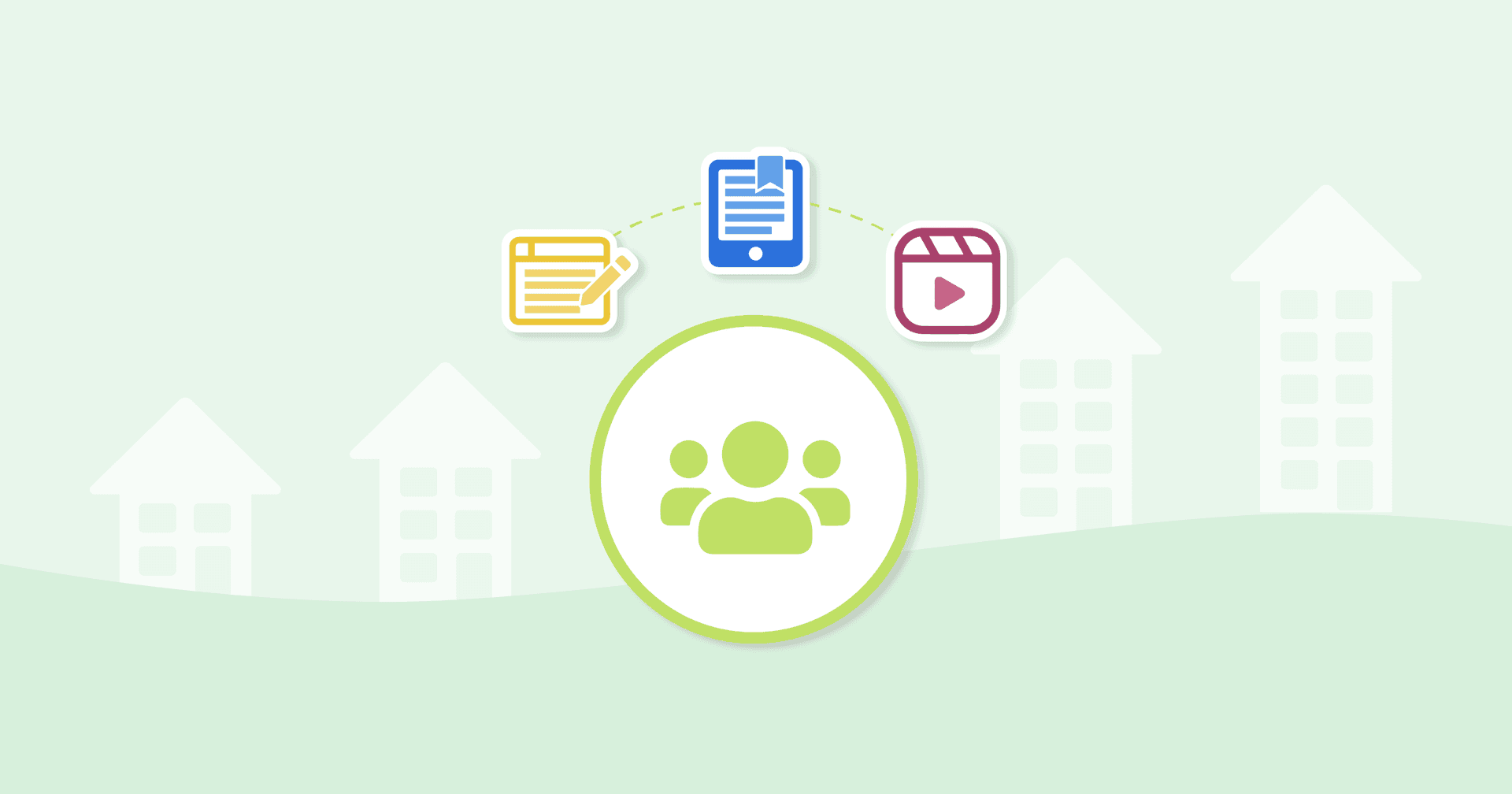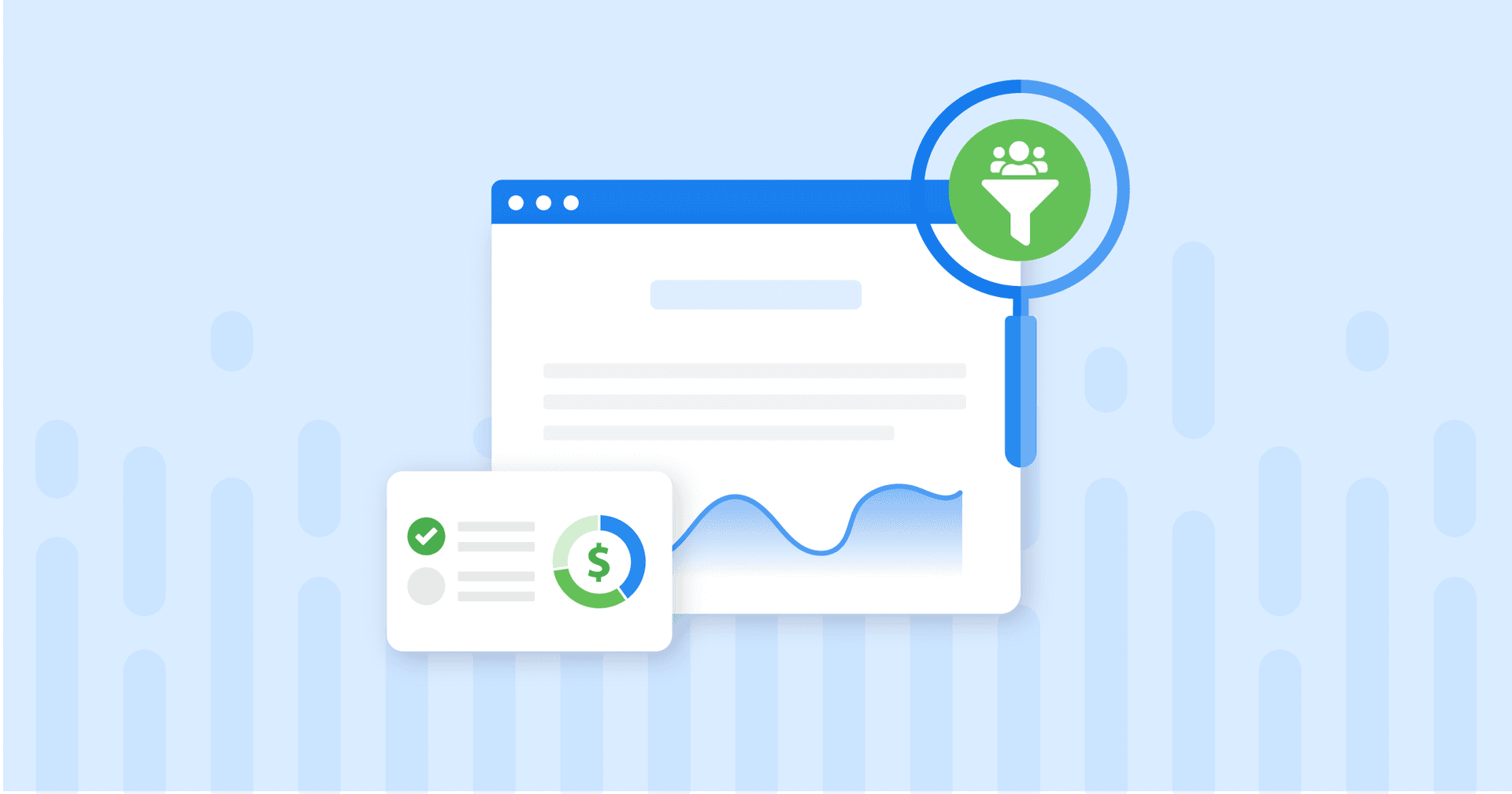Table of Contents
QUICK SUMMARY:
A marketing agency's success hinges on a robust sales funnel. Unlike banking on a few big clients, a well-structured funnel ensures a steady flow of warm leads, safeguarding against turbulent times. Transitioning from ad-hoc tactics to systematic processes is imperative to drive more sales and sustained agency growth. This guide shares key strategies to construct a sales infrastructure that drives conversions and fosters continual expansion.
Owning a marketing agency is a bit like swimming through a storm—hectic, fast-paced, and with little room for error.
Once you find a boat, it’s natural to invest all your energy ensuring it’ll last a lifetime.
But in the marketing world, putting all your effort into a few large clients is a risky strategy.
Instead, it’s essential to build a solid digital marketing agency sales funnel that generates an effective client pipeline. Having warm leads in the queue will calm your nerves when the storm intensifies, providing you with options to keep cash flow afloat during even the most trying times.
The question becomes: How does an agency go about building a sales funnel that will continuously deliver results long-term? Today we’re sharing the top strategies marketing agencies like yours are using today, to create a lasting sales infrastructure for tomorrow.
Basic Stages of an Agency Sales Funnel
If we follow our metaphor, you may be tempted to compare a sales funnel to a life vest—keeping you safe and afloat.
But surviving isn’t the goal. You need to thrive.
Instead, think of your lead generation pipeline as a light flare, leading more boats to you.
In simple terms, a sales funnel represents your client’s journey to conversion. While modern sales funnels don’t always follow the same order, the steps are usually consistent:
Awareness
This is when your target audience finds your agency and makes their way to your website through your marketing funnel.
Interest
At this stage of your lead generation strategy, your agency will offer free value (such as well-written downloadables), in exchange for contact information.
Decision
This is the part of your sales funnel where your prospects learn more about your agency’s value proposition and start to seriously consider signing up.
Action
At this stage of your sales funnel, it’s time to land the sale. For example, a client might agree to the terms of your agency’s proposal, or sign on for an ongoing program (and retainer fee).
Re-Engagement
Sometimes potential leads fall through the cracks. Interest fizzles, prospects get distracted, and the sale is never made.
This stage is about reigniting those interests and pulling people back into the sales funnel. This is a time to address any concerns that may have arisen, and keep communication open about how certain offerings may be tailored to more accurately meet the client’s needs–eventually causing them to convert.
We use a lot of inbound marketing techniques to ensure that we have a really healthy pipeline. This includes having a newsletter, both for our current clients and potential clients. It means setting up or making it very easy to set up calls and talk with us or anyone on our staff and regularly kind of updating our website and staying pretty active, and social media and our blog content.
Tim Akers, Founder, Akers Digital
Benefits of a Formal Agency Sales Funnel
Building a sales pipeline process is key for increased conversions, allowing marketing agency owners to maximize revenue, generate new leads, and scale their businesses.
In the early days of running a marketing agency, sales funnels might look more like a collection of guesswork and spontaneous decisions than a streamlined process. It's a bit like throwing spaghetti at the wall and seeing what sticks. However, as the agency begins to grow and the stakes get higher, this seat-of-the-pants approach doesn't cut it anymore. To keep the machine humming and ensure that every lead or potential client doesn't slip through the cracks, formalizing these sales funnel processes becomes not just a good idea but a necessity.
Making these processes efficient and repeatable ensures that the agency will continue to grow without reinventing the wheel whenever potential customers arrive at the door. It's about finding that sweet spot between creative chaos and operational excellence, where leads are nurtured and converted with the precision of a well-oiled machine, albeit one with a bit of personality.
The goal is to create a revolving door of prospective customers who already know your agency’s strengths and connect with your business ethos. Benefits of building a solid sales funnel include:
Efficient Growth
As your marketing agency grows, your sales funnel continues to supply leads to support further scaling. Strategic planning and optimization of the sales funnel are crucial for aligning this growth with your agency’s business objectives. By managing resources effectively and leveraging data, you ensure that your agency's growth is sustainable, scalable, and aligned with your long-term vision.
Conduct a quarterly review of the sales funnel's performance, focusing on areas that should be optimized for better efficiency.
Develop a resource allocation plan that matches your growth targets, ensuring that you have the right talent focusing on the right tasks at the right time.
Implement data-driven decision-making processes, using insights from your sales funnel to inform strategic planning and operational adjustments.
Finding New Clients During Slow Periods
Your lead generation strategy allows the agency to survive difficult times by creating a pipeline of new clients. If several of your agency’s large contracts will be wrapping up at the same time, warm leads in the pipeline are a way to keep a steady stream of revenue. Focusing on strategic planning and leveraging analytics helps predict and mitigate slow periods before they impact the agency.
Analyze historical data to identify patterns in slow periods, preparing strategies in advance to counter potential revenue dips.
Diversify your lead generation tactics, ensuring your agency is not overly reliant on a single source for new business.
Build strategic partnerships with complementary businesses to create a referral network to supply leads during slower periods.
Closing Deals Faster
Leads that have been properly nurtured already have a level of brand loyalty, making it easier to get them on board as paying customers, and reducing your team's marketing efforts. Strategic enhancements in this area involve refining the lead nurturing process and ensuring that your team is equipped to close deals efficiently, contributing to faster growth and higher revenue.
Implement advanced Customer Relationship Management (CRM) tools to streamline lead nurturing and follow-up processes.
Train your sales team in consultative selling techniques to better address potential clients' needs and close deals faster.
Set up a feedback loop between the sales team and marketing to refine messaging and targeting based on what's working.
Increasing Revenue
Not only does more clients mean more revenue, but high-quality clients who understand your value proposition are more likely to stay for longer, increasing customer lifetime value, and in turn, long-term agency revenue. Focus on strategies that generate qualified leads and retain high-quality clients, both of which are strategic priorities that require a deep understanding of the target market and developing a value proposition that resonates strongly with them.
Develop a client segmentation strategy to tailor your marketing and sales efforts to high-value prospects.
Offer customized digital marketing solutions that address your top segments' specific needs and pain points to increase their lifetime value.
Leverage client success stories to attract similar high-quality clients, showcasing the impact of your agency's work.
Streamlined Tasks
An effective sales pipeline will reduce the amount of time your team spends on business development activities like outreach, cold calling, and prospecting. With a sustainable client pipeline, agencies instead focus their efforts on connecting with qualified leads who already have a level of brand knowledge.
The focus should be on optimizing these processes to ensure team efforts are maximized and aligned with strategic goals.
Automate repetitive tasks within the sales and marketing process to free up your team's time for high-value activities.
Implement a content management system (CMS) to efficiently manage and distribute content, such as proposals and positioning documents.
Regularly train your team on new tools and technologies to keep your processes efficient and effective.
Better Conversion Rates
Creating a client pipeline of qualified leads increases the chances of landing a sale. A recent survey showed that a solid sales funnel and proper lead generation should provide a conversion rate of around 3.1 to 5%. Close rates typically skyrocket once an agency reaches the sales pitch presentation stage. Based on the 2023 Marketing Agency Benchmarks Report, most agencies see a win rate of 51% to 80%.
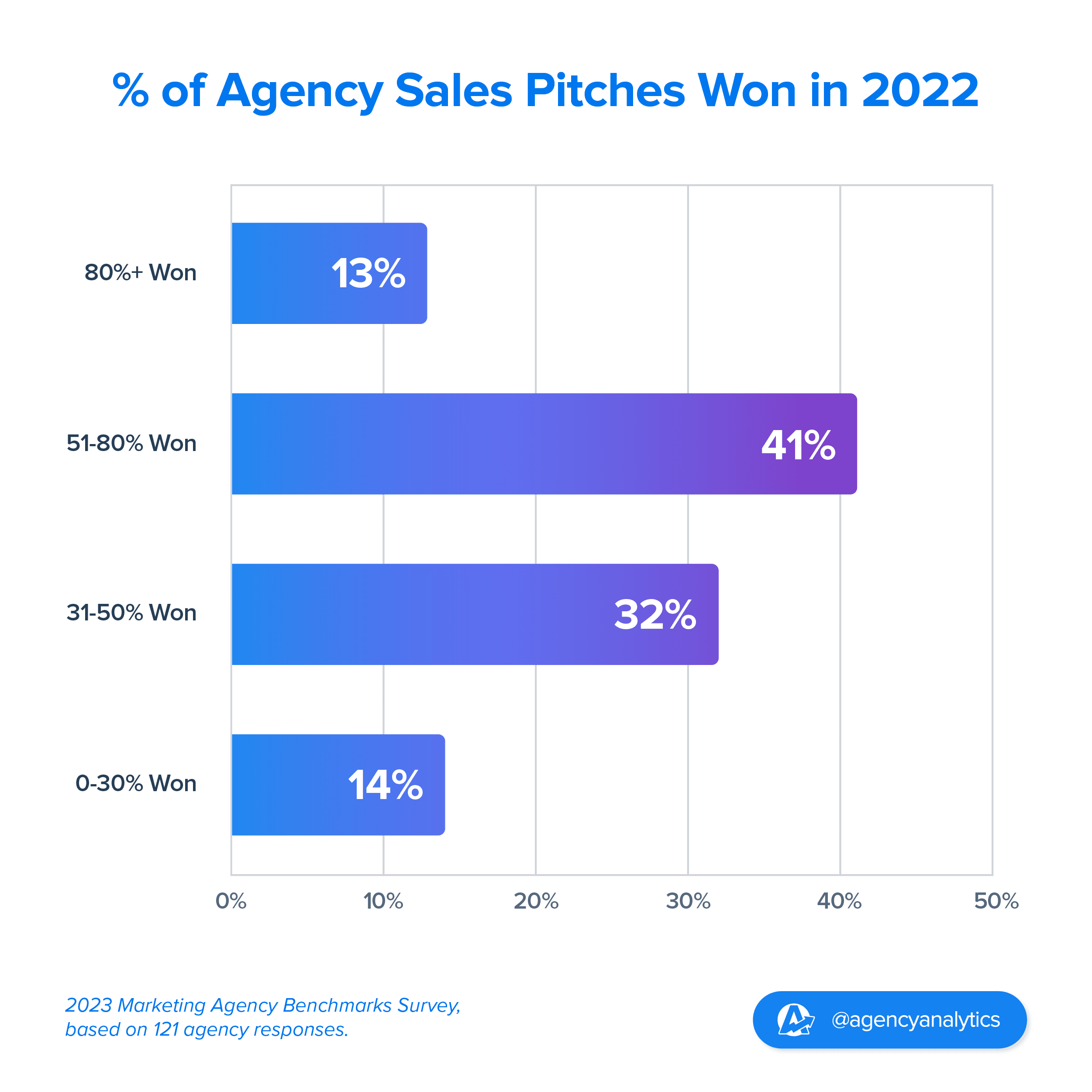
If your agency is not seeing an equivalent rate, create a continuous process of testing, learning, and refining strategies.
A/B test landing pages and calls-to-action to identify what converts best.
Personalize marketing messages based on lead data to increase relevance and engagement.
Analyze conversion funnel metrics regularly to identify bottlenecks and areas for improvement.
Enhanced Client Insights
Since the sales funnel process nurtures leads along, with plenty of connection points for ongoing communication, agencies have the opportunity to collect key data about client behavior and pain points.
Invest in analytics tools that provide deeper insights into client behavior and preferences.
Create a feedback loop where client feedback directly informs service improvements and innovation.
Segment your audience based on behavior and preferences to tailor services and communications effectively.
Before You Build Your Agency’s Client Pipeline
Lead generation looks vastly different depending on the specifics of your agency offering. What brings more leads for one marketer won’t necessarily bring more leads for another.
Why? Because your agency’s lead generation strategy should be built around your target audience rather than a one-size-fits-all industry standard.
We touched on some of these concepts earlier, but before creating a sales funnel, it’s essential to define both your Ideal Client Profile (ICP) and your marketing agency’s unique value proposition.
Determine Your Agency Value Proposition
To build a strong agency value proposition, start by identifying your agency’s unique strengths while taking your clients’ needs into account. What does your team uniquely accomplish for clients that no other competing agency can provide?
Do you make mind blowing vertical videos for TikTok and Instagram Reels? Do you know all the insider hacks to turn a PPC campaign into a runaway success? Is your client management team just the absolute best at supporting small businesses in their early growth stages? Brainstorm with the team and land on an offering that describes what you do best.
Determine Your Agency Ideal Client Profile
To create an ICP, it’s helpful to perform market research while also analyzing your existing clients. Pinpoint which business traits and industries are the best match for your agency and your marketing services.
These will likely change, so it’s important to continuously update your ICP.
Understanding the Stages of Lead Management
While lead management looks different for every sales funnel agency, there are typically five steps to attracting and converting a lead:
Agency Sales Funnel Stage 1: Lead Generation
What It Is:
In this stage, your agency will be focused on building a client pipeline by identifying who could be a potential client and getting their contact info.
How To Do It:
Lead generation is an art unto itself. There are loads of options for drumming up leads, so it’s best to choose those that would work with your specific ICP. Here are some examples:
Referrals
According to the AgencyAnalytics Marketing Agency Benchmarks Survey:
24% of agencies receive the majority of new business from referrals.
21% of agencies receive the majority of new business from word of mouth.
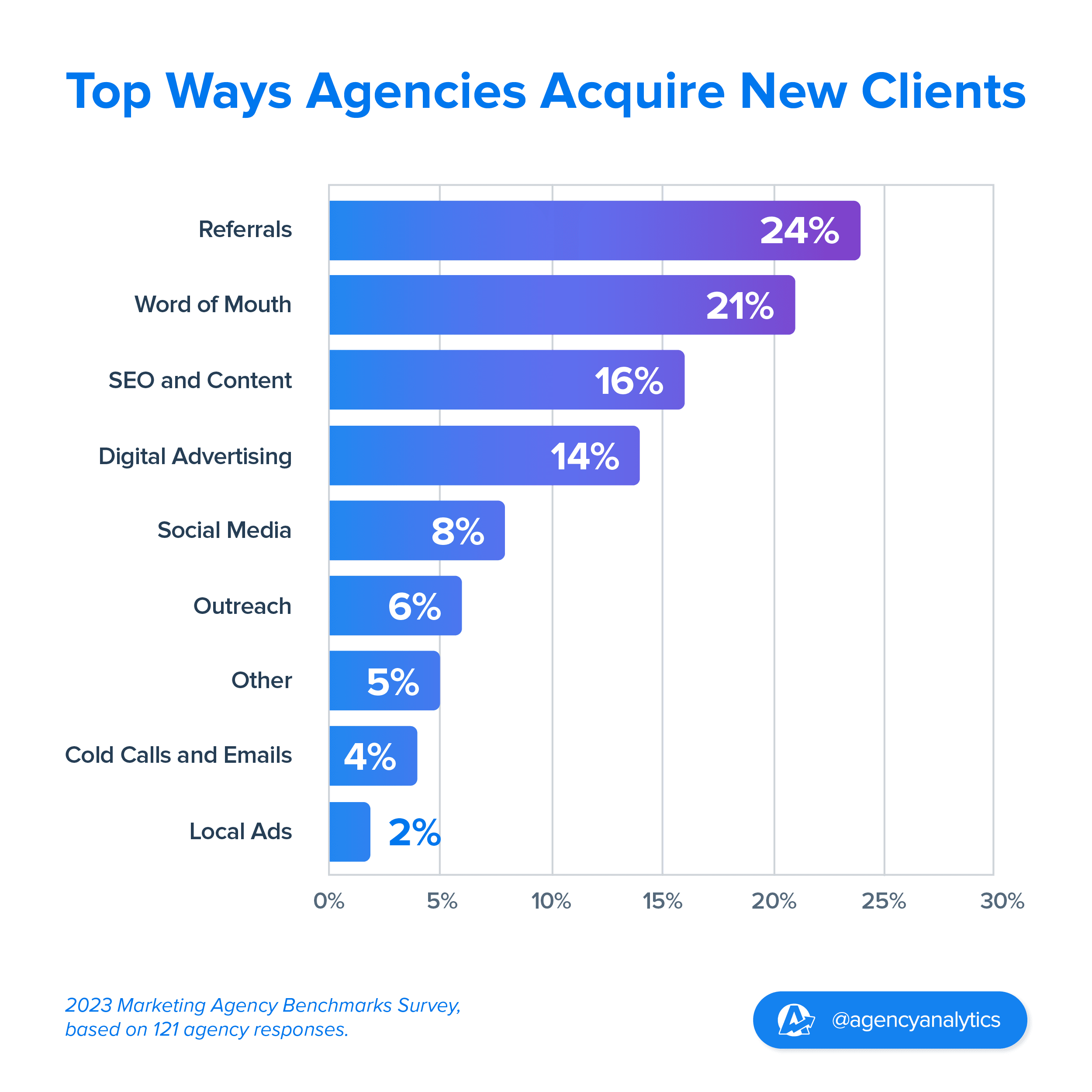
Either way, the point is made: People trust the opinion of others when hiring a marketing agency. So–how does an agency go about drumming up referrals?
The first way is easy: Ask for them. When you receive positive feedback from a client, let them know that you would love it if they could refer your agency to their colleagues.
Past client referrals are huge. I'm always amazed and honored. How many of our past clients refer other practice owners to us.
Jessica Tappana, Founder, Simplified SEO Consulting
Uncomfortable asking for referrals? Consider creating a referral program that rewards clients for bringing in new potential clients. For example, an agency might provide a discount to both those being referred and those doing the referring.
Networking
Conferences and other networking events allow marketing agencies to show off their value proposition face to face while building genuine connections with potential clients. Some agencies choose to speak at events while others invest in booths at conferences in their niche market.
Both are excellent lead generation strategies.
Simplified SEO Consulting, an agency that works with private practice owners, opts to focus on conferences that target their ideal clients.
By meeting potential clients face to face, the agency is able to generate leads while building honest relationships, which is key for the lead generation process.
Our best source of leads is really going to conferences that are in our niche and meeting people face to face. It makes a huge difference.Our ideal clients, our niche is very relationship based. So being able to just talk with them, sometimes sharing a lunch and talking about their business, and quite frankly offering free SEO advice is usually our best source of clients.
Jessica Tappana, Founder, Simplified SEO Consulting
SEO Marketing
SEO and organic traffic strategies are one of the most popular lead generation and marketing tools. By ranking higher on search engines like Google, agencies are able to drive traffic to their websites, leading to more potential clients. When compared to organic social media, SEO strategies drove 1000% more traffic, and leads coming from SEO have a 14.6% close rate.
9 Clouds, a digital lead generation agency, named SEO as one of their most successful lead sources for their digital marketing sales funnel. The agency uses organic keywords to target their ideal clients and find clients in different industries.
We really keep our pipeline full by treating ourselves like one of our clients, so we do strategizing to figure out what services are providing the best return. In our situation, SEO is king. We really want to make sure that we're doing that keyword research to answer the questions that our current clients have, because people who might be a future client are probably asking those questions too.
Jenny Lockhart, Account Services Director, 9 Clouds
Social Media Marketing
Social media allows marketing agencies to not only join the conversation, but drive it.
While online ad campaigns are an effective way to build digital marketing sales funnels, organic social media strategies are just as important for lead generation. Whether on Instagram, Facebook, or LinkedIn, agencies are able to connect with their audiences while building brand loyalty. When used strategically, platforms like LinkedIn are powerful tools for business development.
To get noticed on social media, it’s important to:
Study your market and identify where your audience hangs out (and what they talk about)
Create a consistent social media publishing schedule
Write authentic content on your agency's sales page or lead magnet landing page
Engage as often as possible through comments and posts
Keep a careful eye on engagement metrics. AgencyAnalytics’ automated reporting feature allows agencies to quickly create marketing reports with the most important data.
Social media allowed Simplified SEO Consulting to connect with their niche market, with two clients coming directly from Instagram.
We upped our social media game in 2023, and that's made a difference. We've had at least 2 clients that've come straight from Instagram since then.
Jessica Tappana, Founder, Simplified SEO Consulting
Build Lead Magnets
Some agencies attract clients through freebies tailored to their audience’s pain points. Typically, potential leads get something of value in exchange for their email information or other contact info. For example, an agency may invest in a marketing survey with key statistics that the public can download for free after providing their email address.
Content Marketing
While many of the above strategies will get your target audience to your website, if it’s poorly written, they’ll leave and never come back. Solid content marketing is a key lead generation strategy. For example, your landing page should answer your potential client’s questions while touching on their pain points and explaining your agency’s value proposition.
Blogs and white papers are an effective way to build trust through thought leadership, while case studies help your audience understand how your agency makes a difference, increasing lead generation and strengthening your marketing funnel. Content marketing is also a great way to capture high-value leads and feed them into your agency's email marketing flow.
Akers Digital relies on inbound marketing to create a robust pipeline and boost lead generation. This includes a newsletter for current and potential clients, regular website updates, and blogs.
Agency Sales Funnel Stage 2: Lead Qualification
What It Is:
At this point in the sales process, your agency will start reviewing generated leads to filter out leads who don’t have the budget, decision-making power, or general interest to convert. This will help you focus on the right leads without wasting time on the wrong ones during the lead generation process.
How To Do It:
One way to assess whether a lead in the digital marketing funnel is likely to convert is through lead scoring. This is when a lead gets scored based on their demographics, behavior and engagement rates. For example, if a lead continually comments on your agency’s social media posts, is in the same niche you service, and has signed up for your newsletter, their lead score would be high, meaning they’re likely to convert and will make their way through the sales funnel smoothly.
Agency Sales Funnel Stage 3: Lead Nurturing
What It Is:
Once you’ve identified the strong leads, it’s time to engage with them. During this stage of the lead generation process, your agency will be focused on talking to leads and educating them through personalized content. This step is about building trust and presenting a strong value proposition.
How To Do It:
Email campaigns are often effective ways to reach leads, as are newsletters and content marketing strategies. For example, let’s say you have three strong B2B SaaS leads that all share the same pain point—they struggle to connect with their audience on LinkedIn. In this case, it would be a good idea to write a blog on social media tips and tricks as a way to connect with your audience, then include the link in your email newsletter and on social media.
Agency Sales Funnel Stage 4: Lead Conversion
What It Is:
This is your ultimate objective, when a lead finally converts and becomes a client of the agency. The details of the conversion stage will be different for each agency, and for each client within each agency. Some clients may require minimal effort to nudge them to the finish line, while others will need hand holding and consistent guidance.
How To Do It:
Lead conversion is the culmination of the previous three steps. Some ways to encourage conversion include increased one-on-one time with an account manager, and answering any additional questions or concerns a lead may have before converting. In the case where a sales funnel may be more hands-off, an agency may experiment with A/B testing on CTAs to determine which deliver the best conversion rates.
The best thing you can do is if you get a large client in the door, I would recommend, instead of taking a profit from that newfound success, reinvest it into the business so that you can get more staff. And you can eventually get in more clients that are of the same caliber to grow your agency so that way that one client actually starts to become the regular size of most of your clients. And you can do that by reinvesting into your agency and bringing on better talent and better lead generation.
Kevin Heimlich, CEO and Founder, The Ad Firm
Lead Follow-up
What It Is:
Even when a sale is closed, your job is far from over. Lead follow-ups increase client retention, allowing you to continue to talk to your client and ensure their needs are being met. Through this stage, your agency will be able to maintain strong relationships and catch any client issues before they become a problem.
How To Do It:
Regular check-ins are great for maintaining client connections and assessing campaign progress. Meeting weekly, bi-weekly, or monthly will allow your clients to voice their feedback face to face while keeping them engaged.

Automate client reporting and schedule delivery to align with client check-in meetings: weekly, biweekly, monthly, annually or according to a custom schedule. Join more than 7,000 marketing agency professionals using AgencyAnalytics to enhance client communications–try it free for 14 days!
Tips and Tricks for Building an Agency Sales Funnel
While creating a sales funnel is crucial for your agency’s long-term growth, it’s also a long and often complex process. From attracting leads to convincing them to make the sale, the process involves patience, an excellent understanding of your audience, and a myriad of marketing strategies.
Here are some ways to improve your agency sales funnel:
Understand That Audience Research Is Key
Before creating a lead generation strategy, you need to understand your ideal client. Without audience research, this is hard to do. A thorough research process will help you learn who to target and how to reach them while improving your sales funnel strategy and bringing in more leads. Some tips include:
Analyzing Current Clients: It’s a good idea to start with your most profitable clients, looking for patterns and trends. For example, you may find that a client who connected through social media has higher retention than those that came through a Google search.
Use Client Surveys: This will help you understand what attracted a client to your agency, and what their expectations are.
Leverage Data Analytics: AgencyAnalytics’ custom dashboards tool, for example, allows you to monitor metrics from more than 80 marketing platform integrations, making it easy to track the success of your lead generation campaigns.
Conduct Market Research: Otherwise, you’ll be behind on client expectations.
Be Consistent To Be Successful
Sporadic campaigns aren’t helpful for long-term growth and successful lead generation. It’s important to stay consistent with your lead generation strategy, otherwise your audience won’t have the chance to learn enough about your agency to connect. Consistency allows agencies to:
Create trust with your target audience.
Stay visible from the first quarter to the last.
Build brand loyalty through consistent messaging.
Use Your Network
Every marketing agency has a unique super power—their network of contacts. This is made up of former and current clients, partner agencies, and subject matter experts. Not only is it a great resource for market research, it’s also where most referrals will come from.
To properly leverage your network:
Ensure you’re building strong relationships through trust and credibility.
Engage often. Information sharing is key here.
Keep an eye open for new opportunities.
Prioritize online and offline networking. Industry events are just as vital as social media engagement.
Be proactive. If someone in your network needs support, offer it. Strengthening relationships is vital for an effective network.
Our biggest source of leads for our agency are our current clients. We really aim to have really strong services, really strong communication, really strong reporting, and I think our clients really enjoy that and refer a lot of business to us.
Tim Akers, Founder, Akers Digital
Aim for Quality, Not Quantity
Lead generation is not just a numbers game. Not all leads can be converted. In fact, about 79% of marketing leads won’t turn into a sale. The stark reality is that some leads just won’t be a good fit.
And that’s OK.
You’re not trying to get as many leads as possible, you’re trying to bring in more leads that are solid and will actually convert. Focus your lead generation efforts on high-quality leads that are more likely to increase revenue.
For example, if you’re creating an email campaign, it’s better to send out fewer, personalized emails to a select number of contacts than hundreds of identical emails that won’t connect with anyone.
Boosting Your Agency Sales Funnel
Sales funnel strategies can’t–and shouldn’t—be built overnight. They require thoughtful consideration, audience research, key metrics, and a deep understanding of your ideal client to bring in more leads.
When agencies begin to launch lead generation campaigns, it’s important to keep track of relevant data to understand how well you’re connecting with potential leads. Use AgencyAnalytics to:
Automate reports, allowing you to effortlessly keep up to date with your lead generation campaigns.
Create customized dashboards with metrics from more than 80 marketing platforms.
Track agency leads as they progress through the agency sales funnel with our brand new agency CRM feature (currently available in Labs).
To learn more, try it free for 14 days.

Written by
Rita Poliakov is an experienced content writer with a knack for storytelling. As a former journalist, she's a skilled researcher, interviewer, and grammar nerd.
Read more posts by Rita PoliakovSee how 7,000+ marketing agencies help clients win
Free 14-day trial. No credit card required.


